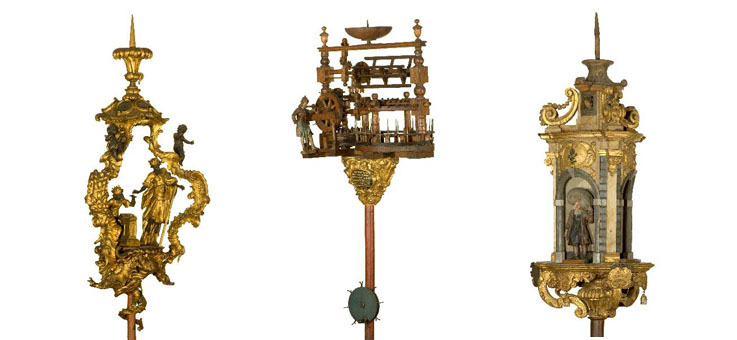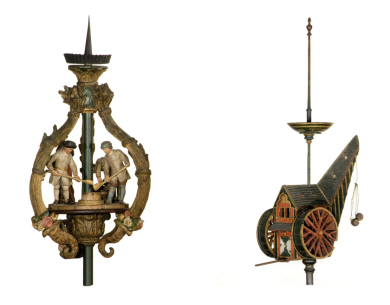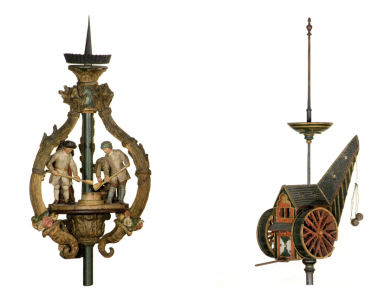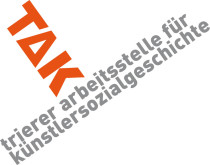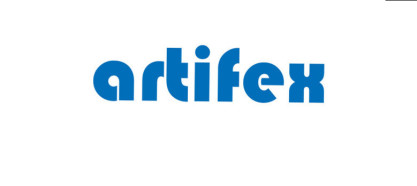Internationale Tagung / International Conference
MATERIAL CULTURE
Präsenz und Sichtbarkeit von Künstlern, Zünften und Bruderschaften in der Vormoderne
Presence and Visibility of Artists, Guilds, Brotherhoods in the Pre-modern Era
München, Zentralinstitut für Kunstgeschichte,
25.–28. Februar 2016
Vortragsraum 242, II. OG (Katharina-von-Bora-Straße 10, D-80333 München)
25. Februar 2016, 18 h: ERÖFFNUNG
Grußworte
Prof. Dr. Ulrich Pfisterer, Direktor des Zentralinstituts für Kunstgeschichte
Zur Tagung
Prof. Dr. Wolfgang Augustyn, Leiter des Reallexikons zur Deutschen Kunstgeschichte
Zu artifex
Prof. Dr. Dr. Andreas Tacke, Dr. Birgit Ulrike Münch, apl. Prof. Dr. Dagmar Eichberger (alle Universität Trier: artifex)
Eröffnungsvortrag
Prof. Dr. Suraiya Faroqhi (Istanbul): Sultansbefehl oder Selbstdarstellung? Handwerkerprozessionen im XVI. und XVII. Jahrhundert
Anschließend Umtrunk
26. Februar 2016, 9 h: Sektion 1, STÄDTISCHE RÄUME: ANTWERPEN ALS BÜHNE FÜR KÜNSTLER UND ZÜNFTE
Chair: Prof. Dr. Nils Büttner (Staatliche Akademie der Bildenden Künste Stuttgart)
Prof. Dr. Nils Büttner (Staatliche Akademie der Bildenden Künste Stuttgart): Introduction to the conference themes: Peter Paul Rubens
Prof. Dr. Dan Ewing (Barry University): Guild Work, Guild Glory: Sixteenth-Century Antwerp Painters' Work for the St. Luke's Guild
Pause
Dr. Petra Maclot (KU Leuven): Status and all' antica architecture: artists' homes, the town hall and guildhouses in Antwerp between 1560 and 1585
Dr. Beatrijs Wolters van der Wey (Antwerp): Corporate Splendour Indoors. The Role of the Furnishing of the Guildroom in the Formation and Expression of the Guilds’ Identity and Status in Seventeenth- and Eighteenth Century Antwerp
26. Februar 2016, 14 h: Sektion 2, BRUDERSCHAFTEN UND GILDEN ALS AUFTRAGGEBER
Chair: apl. Prof. Dr. Dagmar Eichberger (Universität Trier: artifex)
Dr. Ingrid Falque (Université catholique de Louvain): Visualizing Cohesion, Identity and Piety: Portraits of Guilds and Brotherhoods in Early Netherlandish Painting
Prof. Dr. Henry Martin Luttikhuizen (Calvin College): Kindred Spirits: Geertgen tot Sint Jans and the Haarlem Brotherhood of Saint John the Baptist
Pause
Megan C. Blocksom (University of Kansas): Representation and Ritual in Adriaen van Nieulandt’s The Procession of Lepers on Copper Monday, 1633: Extolling Civic Virtues
Prof. Dr. Pascale Rihouet (Rhode Island School of Design): The Material Culture of a Confraternity’s Public Life: the Annunziata in Perugia (Italy), 14th-17th c.
27. Februar 2016, 9 h: Sektion 3, KONKURRENZ IM KIRCHENSHIFF
Chair: PD Dr. Martin Gaier (Universität Lüneburg)
Prof. Dr. Stefan Bürger (Universität Würzburg): Hinweise auf bruderschaftliches und zünftiges Engagement in spätgotischen Kirchen Sachsens und angrenzender Regionen
Prof. Dr. Philipp Zitzlsperger (Hochschule Fresenius - AMD, Standort Berlin): Anton Pilgrams letzter Streich. Hinterlist und Selbstdarstellung eines Künstlers im Wiener Stephansdom
Pause
Dr. Gabor Endrödi (Budapest): Objekte und historische Überlieferungen in der Auseinandersetzung der deutschen und italienischen Baumeister in Wien im 17. Jahrhundert
Matthijs Jonker, PhD Candiate (Amsterdam): The Cappella di San Luca: A Crossing Point of Religious and Professional Activities of Artists in Pre-modern Florence
27. Februar 2016, 14 h: Sektion 4, ZÜNFTE UND REPRÄSENTATION I - DAS MARGINALISIERTE OBJEKT
Chair: Prof. Dr. Sabine von Heusinger (Universität Köln)
Dr. Vera Henkelmann (Eschweiler): Das Beleuchtungswesen der Bruderschaften und Zünfte im Spätmittelalter – Gestaltung und Funktion im Spiegel der tradierten Sachkultur und Schriftüberlieferung
Dr. Jens Kremb (Bonn): Zunftscheibe, Zunfttafel, Totentafel oder Meistertafel? Die runden Wappenschilde der Zünfte
Pause
Audrey Ginoux (Lyon): Der Malstock zwischen Zunfteingebundenheit und künstlerischer Emanzipation: Zur visuellen Kulturgeschichte eines bisher wenig beachteten Werkzeugs
Prof. Dr. Marc Jacobs (Director of the Flemish Interface for Cultural Heritage - FARO): Small dramaturgy of a procession of artefacts: about the movable and intangible heritage of early-modern guilds in the Southern Netherlands
28. Februar 2016, 9 h: Sektion 5, ZÜNFTE UND REPRÄSENTATION II - GEMALTE BILD-RÄUME
Chair: Prof. Dr. Eva-Maria Seng (Universität Paderborn)
Dr. Martin Roland (Österreichische Akademie der Wissenschaften, Wien): Die Funktion des Bildes bei mittelalterlichen Bruderschafts- und Zunft-Urkunden
Dr. Michael Roth (Kupferstichkabinett, Staatliche Museen zu Berlin - Preußischer Kulturbesitz): Die „Augsburger Malerbildnisse“ des Meisters mit dem Zeichen BB zwischen Freundschaftsalbum, Ehrentafel und historischer Fiktion
Pause
Danica Brenner M.A. (Darmstadt): Material culture der Augsburger Malerzunft: Die Funktion zünftischer Insignien und ihre Aneignung durch Karl V. als Symbol der kaiserlichen Machtübernahme im Kontext des „Geharnischten Reichstages“
Dr. Martin Möhle (Kantonale Denkmalpflege, Basel): Gelehrte Fassadenmalerei: Bildliche Repräsentation der Basler Schmiedenzunft im 17. Jahrhundert
Tagungsende 13 Uhr
Die Tagung wird gefördert durch das EU-Projekt artifex (Prof. Dr. Dr. Andreas Tacke) der Universität Trier sowie durch das Zentralinstitut für Kunstgeschichte (München)
Zum download:
PDF-Dokument [16.8 MB]
PDF-Dokument [5.0 MB]
Call for Papers
For english version, see below...
Version française de traduction, voir ci-dessous...
München, Zentralinstitut für Kunstgeschichte, 24.-28. Februar 2016
In den vergangenen Jahren hat der „material turn“ in zahlreichen geistes- und sozialwissenschaftlichen Disziplinen zur Stimulanz neuer Fragen, neuer Forschungsbereiche und neuer Forschungsperspektiven geführt. Das vielzitierte „thinking through things“ ist gerade im Bereich der Sammlungs- und Museumsgeschichte essentiell. Dennoch sind trotz der dem Fach Kunstgeschichte immanenten Objektgebundenheit – etwa im Vergleich zu Archäologie und Kulturanthropologie – erstaunlicherweise zahlreiche Forschungsthemen noch kaum bearbeitet, obgleich sie einen zentralen Bereich des vormodernen Künstlerselbstverständnisses bilden: Die Rede ist von jenen Objekten materieller Kultur, die die städtischen Berufsverbände im Handwerk und Gewerbe repräsentierten und so das Zunft- Gilde- und Bruderschaftswesen im städtischen Kontext visualisierten. Sämtliche in diesem Bereich angesiedelten Objekte stehen hierbei im Zentrum des Interesses, der Begriff material culture des Zunft- und Gildewesens wird auf der Tagung in breitest möglicher Dimension verstanden, vom mehrflügeligen Altar bis zum schlichten Zunftschrank, der die Kerzen für die städtischen Prozessionen beherbergte. Von Interesse sind die Form, Wirkung und Funktion dieses Objekt in seinem sakralen oder profanen Umfeld.
Die wichtigsten Akteure sind hierbei vor allem die städtischen Gilden. In ähnlicher Weise agieren die zünftischen Bruderschaften, die sich um die sozialen und religiösen Belange ihrer Gilde kümmern. Auch die offiziellen Vertreter der Stadt konnten auf in der Gestaltung ihres Rathauses und des Stadtbildes Einfluss nehmen, um die soziale Struktur ihrer Gemeinschaft ins Blickfeld zu rücken. Wann kommt es zu konkurrierenden Projekten zwischen den unterschiedlichen Berufsgruppen? Inwieweit wird dem Individuum Raum für persönliche Stiftungen gewährt? Der Bildende Künstler oder auch der Architekt spielt bei der Selbstdarstellung der Zünfte, aber auch von Einzelpersonen und generell bei der Gestaltung des öffentlichen Raumes eine zentrale Rolle. Er ist derjenige, der Gemälde, Fahnen, Glasfenster, Handschriften, etc. nach den Vorgaben des Auftraggebers entwirft und ausführt. Seine Kunstfertigkeit verleiht den Gilden Glanz, seine visuellen Angebote übersetzen den Darstellungswillen der Gruppe in konkrete Bildbotschaften. Wer ist für die Ausgestaltung zünftischer Räume verantwortlich? Welche Künstler werden für diese Aufträge herangezogen und wie gehen sie mit der jeweiligen Aufgabe um?
Die Räume, in denen sich die gemeinschaftlichen Aktivitäten abspielen, können unterschiedlichster Art sein. Der städtische Raum bildet quasi die Bühne, auf der sich die Handwerksverbände bewegen und ihre Realien zur Schau stellen können. Hierbei kann es sich um den zentralen Platz, das Rathaus, die Kirche mit verschiedenen Gildenkapellen oder auch das individuelle Zunfthaus handeln. Neben diesen verortbaren Räumen bilden die unterschiedlichsten ephemeren Räume einen ebenso zentralen Bereich: ob kommunale Festzüge, kirchliche Prozessionen, festliche Herrschereinzüge oder Totenfeierlichkeiten, wann immer die verschiedenen städtischen Gruppen in der Öffentlichkeit auftraten, mussten sie als Vertreter ihres Standes erkennbar sein. Hierbei spielten Realien wie Zunftkerzen, berufsspezifische Wappen und Standarten mit Zunftmotiven eine wichtige Rolle. Ebenso konnte die Reihenfolge, in der die jeweilige Gruppe an einer Prozession teilnahm, den Status der Zunft im städtischen Kontext signalisieren. Hierbei handelt es sich um ephemere Prozesse, die in schriftlicher oder bildlicher Form festgehalten werden konnten. Die Zunftkapellen dienten als öffentlich zugängliche Bereiche, in denen die Gemeinschaft ihr Erscheinungsbild nach eignen Vorstellungen prägen konnte.
Neben den unterschiedlichen Akteuren und Räumen soll die Tagung herausarbeiten, inwieweit das spezifische Objekt in der Vormoderne zur Repräsentation, zur Machtsicherung aber auch zum Wissenstransfer eingesetzt wurde und inwieweit es heute – oftmals seines Kontextes vollständig beraubt – zum Verständnis des Gilde- und Zunftswesens dienen kann. Die interdisziplinär angelegte Tagung möchte hierbei die visuellen und haptischen Dimensionen des Objekts ebenso einbeziehen wie etwa auch wissenschaftsgeschichtliche Fragen an das Thema.
Zu den möglichen Themenkomplexen der Tagung zählen etwa:
- Gilde-, Bruderschafts - und Zunfthäuser im Zentrum der Stadt (Standort, Architekturformen, Ausstattung).
- Rathäuser und zünftische Ausstattungsstücke (z.B.: Meisterstücke, Geschenke einzelner Künstler).
- Sakralräume im Kirchenschiff (Zunftaltäre/ Ausstattung, Bruderschaftskapellen, etc.).
- Glasfensterzyklen für städtische Berufsgruppen
- Zünfte und konfessionelle Ausrichtung
- Städtische Prozessionen /ephemere Kunst
- Künstler als Mitglieder religiöser Bruderschaften
- Künstler in kommunalen Organisationen
- Künstlerfeste der Vormoderne
- Künstlerbegräbnis innerhalb der Gilde / Zunft
- Namen und Bezeichnungen von Bruderschaften
- Wettbewerbe
- Zunftheilige und kultische Verehrung
- Theorien zu Material Culture und Material Turn
- Topographie der Material Culture des Zunftwesens (Inventare, Klapptafeln, Zunftruhen, Willkom-Kannen)
- Sammlungsgeschichte der Objekte
- Wissenschaftsgeschichtliche Fragen im inner- wie intradisziplinären Kontext (u.a. Zunftforschung 19./20. Jahrhundert; Material Culture Studies und Begrifflichkeit(en) in Deutschland im Vergleich zum europäischen Ausland und den USA)
Die Konferenz wird vom ERC-Projekt artifex (www.kuenstlersozialgeschichte-trier.de/tak-sharc/artifex/) veranstaltet. Als idealer Tagungsort konnte das Zentralinstitut für Kunstgeschichte in München gewonnen werden, ist doch hier die "Forschungsstelle Realienkunde" angesiedelt, welche sich ausdrücklich der materiellen Kultur in vielfältigen Dimensionen widmet.
Rahmenbedingungen: Der Veranstalter wird für Transport und Unterkunft der Sprecher aufkommen. Nähere Informationen werden nach der Auswahl der Vortragenden und der Zusammenstellung des Programms bekanntgegeben.
Voraussetzung für die Teilnahme: Eine zeitnahe Publikation der Tagungsergebnisse ist beabsichtigt. Aus diesem Grund wird erwartet, dass die ausgewählten Sprecher bereits zum Zeitpunkt der Konferenz einen druckreifen Text mit Fußnoten, Bibliographie und Bildvorlagen vorlegen werden. An diesem Text können im Anschluss an die Konferenz nur wenige Anpassungen vorgenommen werden, bevor das Manuskript im Sommer 2016 beim Imhof Verlag Petersberg in Druck gehen wird. Revidierte Texte mit druckfähigen Abbildungen müssen den Veranstaltern somit bis spätestens am 31. März vorliegen.
Einsendeschluss für Abstracts: 30. April 2015
Die Vorträge sollen eine Länge von 30 Minuten umfassen. Wir erbitten Abstracts von max. einer Seite Länge plus eines Kurzlebenslaufs mit den wichtigsten Publikationen an:
guilds@uni-trier.de
Organisationsteam:
Prof. Dr. Dr. Andreas Tacke / apl. Prof. Dr. Dagmar Eichberger / Dr. Birgit Ulrike Münch
International Conference of the ERC Project artifex: “Material Culture. Presence and Visibility of Artists, Guilds, Brotherhoods in the Pre-modern Era”
Munich, Zentralinstitut für Kunstgeschichte, 24-28 February 2016
In recent years, the material turn has led to stimulating new questions, new research areas and new research perspectives in numerous humanities and social science disciplines. The often quoted “thinking through things” is essential, especially in the area of the history of collections and museums. Nevertheless, it is astounding that numerous research themes have hardly been worked on despite the immanent connection of objects to the discipline of art history, for example, in comparison to archaeology and cultural anthropology – although such research themes form a major area of the pre-modern self-conception of the artist. Speaking of those objects of material culture representing the civic associations in crafts and business the conference seeks to make visible the system of guilds and brotherhoods in a townscape. All those objects making up this area of study play the major role here. At this conference, the term material culture of the guild and crafts system is to be understood in its broadest possible dimensions, from multi-panel altar to the simple guild cabinet storing the candles for the civic processions. Of interest are the form, effect and function of these objects in their sacred and profane surroundings.
The most important players are primarily the civic guilds. In like manner, the guild-like brotherhoods play a role, associations which looked after the social and religious matters of their guilds. In addition, the official representatives of the town could have an influence on the design of their town hall or townscape to bring the social structure of their confraternity into focus. When did it come to competing projects among the different crafts groups? To what extent was individual space guaranteed for persons to found donations? The visual artist or even the architect played a major role in the public portrayal of the guilds, but also of individual persons, and generally in the design of public space. He was the one who designed and carried out the paintings, flags, glass windows, manuscripts etc. according to the guidelines of the patrons. The artist’s craftsmanship lent glory to the guilds; his visual offerings translated the group’s will to self-portrayal into concrete visual messages. Who was responsible for the decoration of the guild rooms? Which artists were called on for these commissions, and how did they deal with each task?
The spaces where the group activities were played out could be of different kinds. The civic space formed the stage, so to speak, where the crafts associations acted on stage and where their realia were put on display. It could have been a centrally located square, the town hall, the church with various guild chapels or even the individual guild house. Along with these locatable spaces, the most diversified temporary spaces formed a major area as well: whether communal festive parades, church processions, festive ruler entrances or funeral ceremonies, the groups had to be visible as representatives of their rank. Realia such as guild candles, crafts-specific coats of arms and standards with guild motifs played an important role. The succession in which the respective group participated in a procession could also signify the status of the guild in the civic context. These were transitory processes which could be preserved in written or visual form. The guild chapels served as publically accessible areas where the confraternity could create its public image according to its own ideas.
In addition to the different players and spaces, the conference is to work out the extent to which the specific object was put to use in the pre-modern era to display splendour, to secure power but also to transfer knowledge and the extent to which the object, often robbed completely of its context, can serve today to understand the guild and crafts system. This interdisciplinary conference wishes to integrate the visual and tactile dimensions of the object as well as the questions on this topic dealing with the history of science and technology.
Among the possible conference group of themes are, for example:
- Crafts, brotherhood and guild houses in town centres (location, architectural forms, furnishings).
- Town halls and guild house furnishings (for example, reception pieces, gifts by individual artists).
- Sacred spaces in church naves (guild altars / furnishings, brotherhood chapels etc.).
- Stained-glass window cycles for civic crafts groups
- Guilds and religious orientation
- Civic processions / temporary art
- The artist as a member of a religious brotherhood
- The artist in communal organisations
- Artists’ celebrations in the pre-modern era
- The artist‘s funeral within the guild
- Names and designations of brotherhoods
- Competitions
- Guild saints and religious veneration
- Theories on material culture and material turn
- Topography of material culture of the guild system (inventories, clap boards, guild chests, welcome pitchers)
- History of collecting the objects
- Questions in the history of science and technology in the inner- as well as intra-disciplinary context (for example, guild research in the 19th/20th century; material culture studies and concepts and terms in Germany compared to those in other parts of Europe and in the US)
The conference is organised by the ERC Project artifex (www.kuenstlersozialgeschichte-trier.de/tak-sharc/artifex/). We were able to secure the Central Institute for Art History in Munich as the ideal conference location. It is, after all, the seat of “Forschungsstelle Realienkunde”, which is devoted expressly to material culture in its manifold dimensions.
Conference conditions: The organiser will pay for transport and accommodations for the speakers. More detailed information will be announced following the selection of the speakers and the arrangement of the programme.
Participation requirements: A publication of the conference proceedings is planned for shortly after the conference ends. For this reason, the selected speakers are expected to have a text with footnotes, bibliography and images already prepared for publication at the time of the conference. Following the conference only a few alterations can be made to the text before the manuscript goes into print at Imhof Verlag Petersberg in the summer of 2016. Revised texts with printable images must therefore be available for the organisers at the latest on 31 March.
Deadline for submitting abstracts: April 30th 2015
The talks should be 30 minutes long. We request that abstracts, no longer than one page, plus a brief CV with the most important publications be submitted to:
guilds@uni-trier.de
Organisation team:
Prof. Dr. Dr. Andreas Tacke / apl. Prof. Dr. Dagmar Eichberger / Dr. Birgit Ulrike Münch
Conférence internationale du projet ERC- artifex: „Material Culture. Présence et visibilité des artistes, des corporations et des confréries dans la période prémoderne“
Munich, Zentralinstitut für Kunstgeschichte, du 24 au 28 février 2016
Au cours des dernières années le „material turn“ a incité dans de nombreuses disciplines sociologiques et des sciences humaines à se poser de nouvelles questions et à créer de nouveaux domaines de recherche et de nouvelles perspectives. La locution souvent citée „thinking through things“ est essentielle, surtout dans le domaine de l´histoire des collections et des musées. Cependant, malgré la connexion immanente des objets en histoire de l´art - en comparaison avec l´archéologie et l´anthropologie culturelle - on est surpris de constater que de nombreux sujets de recherche sont à peine traités à ce jour malgré leur rôle central dans le domaine de l´autocompréhension des artistes dans la période prémoderne. Il s´agit des objets de culture matérielle que les regroupements professionnels urbains de l´artisanat et du commerce représentaient. Ils visualisaient ainsi l´ensemble des corporations, guildes et confréries dans le contexte urbain. Tous les objets de ce domaine sont au centre d´intérêt, pendant la conférence la notion material culture concernant les corporations et confréries sera comprise dans son sens le plus large, de l´autel à plusieurs volets à la plus simple armoire de la corporation où se trouvaient les cierges utilisés lors des processions urbaines. Forme, impact et fonction de cet objet présentent un intérêt particulier dans un contexte sacral ou profane.
Ce faisant, les acteurs les plus importants sont surtout les guildes urbaines. De façon similaire interviennent les confréries des corps de métier qui s´occupent des intérêts sociaux et religieux de leur guilde. Les représentants officiels de la ville pouvaient aussi exercer une influence sur l´aménagement de leur hôtel de ville et la physionomie de la ville, afin d´attirer l´attention sur la structure sociale de leur communauté. A quel moment apparaissent des projets concurrents entre les différents groupes des métiers? Dans quelle mesure donne-t-on à l´individu de la place pour ses fondations personnelles? L´artiste ou l´architecte joue un rôle central en règle générale dans l´aménagement de l´espace public et pour représenter les corporations et les individus. C´est lui qui conçoit et réalise les tableaux, les drapeaux, les vitraux, les manuscrits etc. selon les données du donneur d´ordre. Son habileté donne du prestige aux guildes, ses offres traduisent la volonté de représentation du groupe par des messages visuels. Qui est responsable de la réalisation des espaces corporatifs? Quels artistes sont mis à contribution pour ces commandes et comment gèrent-ils leur tâche?
Les espaces où se déroulent les activités communes peuvent être de nature très différente. L´espace urbain est en quelque sorte la scène où les regroupements artisanaux se déplacent et peuvent exhiber leurs objets. Que ce soit la place centrale, l´hôtel de ville, l´église avec diverses chapelles de guildes ou bien la maison de la corporation. A côté de ces espaces localisables, d´autres endroits éphémères extrêmement différents constituent également un domaine primordial: lors des défilés municipaux, des processions, des entrées festives des souverains dans la ville ou des funérailles, on devait toujours identifier les différents groupes urbains comme représentants de leur communauté quand ils apparaissaient en public. Les objets tels que les cierges des corporations, les armoiries spécifiques aux métiers et les étendards avec les motifs des corporations y jouaient un rôle important. De même, le rang que prenait le groupe dans la procession pouvait signaliser le statut de la corporation dans le contexte urbain. Ce sont des processus éphémères qui ont pu être consignés par écrit ou en images. Les chapelles des corporations étaient des lieux ouverts au public où la communauté pouvait forger son identité visuelle à son gré.
Hormis les différents acteurs et lieux, la conférence fera ressortir dans quelle mesure à l´époque prémoderne on a eu recours à l´objet spécifique pour la représentation mais aussi pour sauvegarder le pouvoir et transmettre le savoir. Et dans quelle mesure il peut de nos jours servir à comprendre les guildes et les corporations, souvent totalement hors du contexte. La conférence interdisciplinaire veut y inclure les dimensions visuelles et haptiques de l´objet ainsi que les questions d´ordre scientifique et historique à ce sujet.
La thématique regroupe entre autres:
- Maisons de guildes, confréries et corporations au centre-ville (site, forme architecturale, aménagement).
- Hôtels de Ville et équipement des corporations (par exemple: chefs d´œuvre, présents de certains artistes).
- Espaces sacraux dans la nef (autels/équipement, chapelles de confréries, etc.).
- Vitraux pour les groupes professionnels de la ville
- Corporations et orientation religieuse
- Processions urbaines/art éphémère
- Artistes membres de confréries religieuses
- Artistes dans des organisations urbaines
- Festivités des artistes à l´époque prémoderne
- Funérailles d´artistes au sein de la guilde/corporation
- Noms et intitulé des confréries
- Compétitions
- Saints des corporations et vénération cultuelle
- Théories du Material Culture et Material Turn
- Topographie de Material Culture des corporations (inventaires,
panneaux rabattables, coffres, pots de bienvenue) - Histoire de la collection des objets
- Questions d´ordre scientifique et historique dans le contexte inter- et intra-disciplinaire (par exemple recherche sur les corporations au
19 ème et 20ème siècle; Material Culture Studies et terminologie(s) en Allemagne en comparaison avec les autres pays d´Europe et les USA).
La conférence est organisée par le projet ERC artifex (www.kuenstlersozialgeschichte-trier.de/tak-sharc/artifex/). L´institut central d´histoire de l´art de Munich est un emplacement idéal hébergeant l´unité de recherche "Realien" qui se voue expressément à la culture matérielle dans ses dimensions multiples.
Conditions générales: L´organisateur assumera les frais de transport et d´hébergement des speakers. De plus amples informations, en particulier le programme, seront communiqués après la sélection des intervenants.
Conditions de participation: une publication des résultats de la conférence est prévue dès que possible. C´est pourquoi il est attendu des speakers qu´ils remettent au moment de la conférence un texte prêt à imprimer, comprenant les notes en bas de page, la bibliographie et les reproductions. Après la conférence, on ne pourra faire que très peu de modifications avant d´envoyer le manuscrit en été 2016 à la maison d´édition Imhof Verlag Petersberg. Les textes corrigés y compris les reproductions en format imprimable devront parvenir aux organisateurs au plus tard le 31 mars 2016.
Date limite d´envoi des résumés: 30 avril 2015
Les exposés auront une durée de 30 minutes. Nous vous prions de nous faire parvenir des résumés d´une page maximum avec un bref curriculum vitae et vos plus importantes publications à:
Équipe organisatrice:
Prof. Dr. Dr. Andreas Tacke / apl. Prof. Dr. Dagmar Eichberger / Dr. Birgit Ulrike Münch

